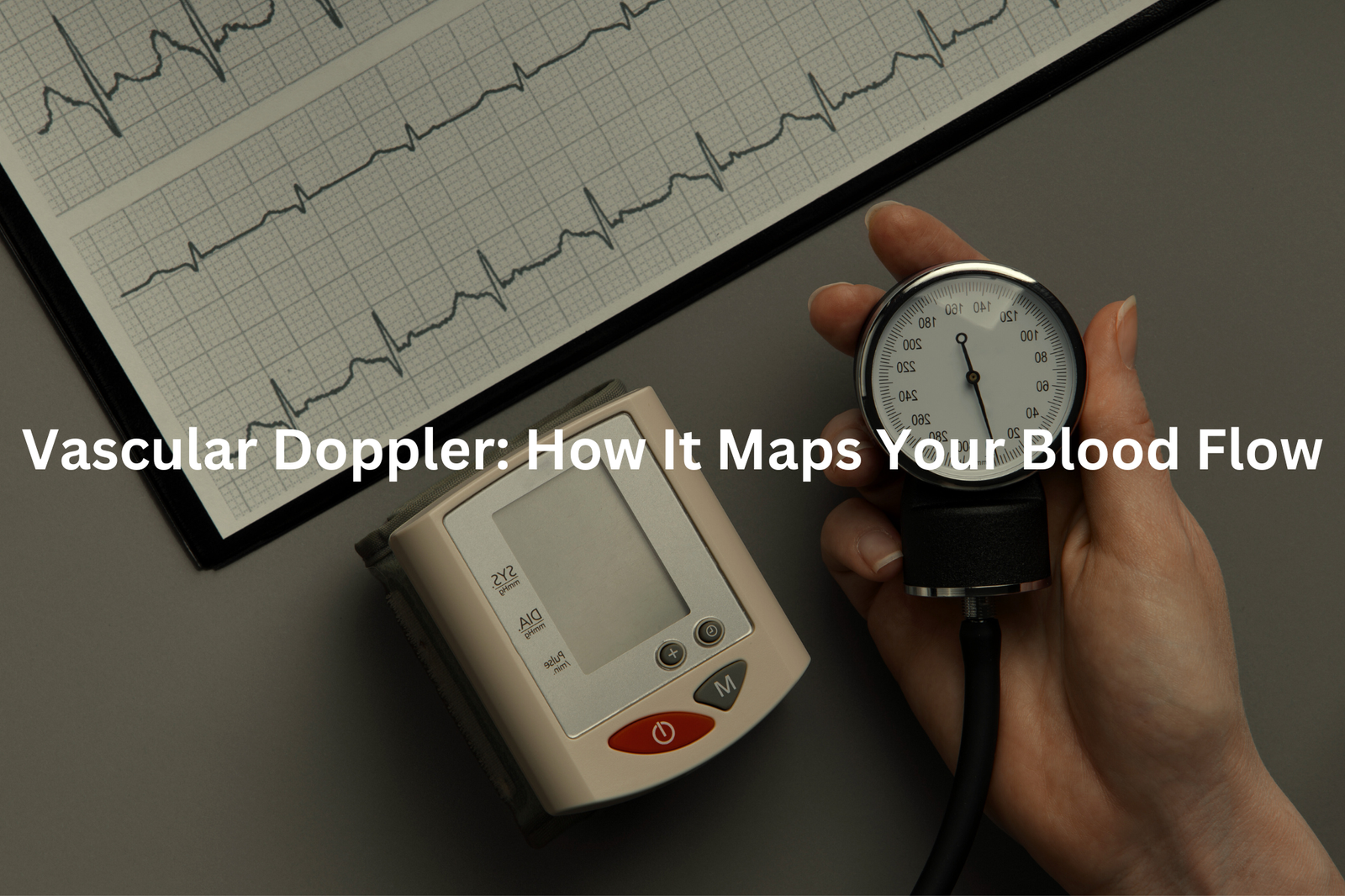Curious about your blood flow? Discover how Vascular Doppler helps doctors see inside your body and why it’s so important for your health.
Vascular Doppler tests show blood flow patterns in vessels through sound waves (operating at frequencies between 2-10 MHz). The device picks up movement inside veins and arteries, creating detailed maps of circulation. Medical specialists use these non-invasive scans to spot blockages, clots, and narrowed vessels without any cuts or needles.
The whole process takes about 30 minutes, and patients can wear their regular clothes. The technology helps doctors make quick decisions about treatment options for various blood vessel conditions. Want to know more about how Vascular Doppler can help you? Keep reading! You just might discover something valuable about your own health and well-being.
Key Takeaway
- Vascular Doppler uses sound waves to check blood flow in arteries and veins.
- It helps doctors diagnose problems like blood clots or peripheral arterial disease.
- The test is quick and doesn’t hurt, and you can go back to your normal activities right after!
What is Vascular Doppler?
A Vascular Doppler scan maps blood flow through vessels, much like sonar tracking movement underwater. The device sends sound waves into the body that bounce off blood cells, creating a real-time picture of circulation patterns.
Medical professionals use this non-invasive test (takes about 30 minutes) to spot several conditions:
• Blood clots in deep veins
• Narrowed arteries with reduced flow
• Poor leg circulation from peripheral artery disease
During the scan, a probe covered in cool gel moves across the skin. No needles or radiation needed. The machine converts returning sound waves into data about blood speed and direction, different from standard ultrasounds that only show still images.
People with diabetes, smoking history, or high cholesterol often need these scans. The test helps check how well stents or bypasses work after surgery too. Early detection of blood flow problems lets doctors start treatment before complications develop, whether through medication or surgical options.
How Does a Vascular Doppler Test Work?
A Vascular Doppler scan creates a whooshing sound as it detects blood flow through vessels. This medical test helps doctors check circulation problems, much like listening to an engine’s performance.
During the examination, patients rest on an exam table while a healthcare provider applies a special gel to the skin. The gel works as a conductor for the ultrasound waves. A small probe moves across the area being checked, picking up sounds of blood movement.
The process takes 30-45 minutes (depending on the area being examined) and doesn’t need any needles or special preparation. Patients can return to normal activities straight after the test.
This non-invasive procedure suits people with:
- Diabetes
- High cholesterol levels
- Poor circulation
- Unexplained leg pain
The scan detects potential blockages or narrowing in blood vessels before symptoms become obvious. Test results typically arrive after a specialist reviews the collected data. The procedure proves particularly useful for early detection of vascular diseases, allowing for timely treatment options.
Why is Vascular Doppler Important?
A Vascular Doppler test spots blood flow problems before they turn serious. The scan works like a radar system for blood vessels (using ultrasound waves at 2-10 MHz), creating detailed maps of circulation.
Medical professionals use this non-invasive test to check three main issues(1):
• Peripheral arterial disease – reduced blood flow in legs and feet
• Deep vein thrombosis – blood clots in deep veins
• Carotid artery disease – blocked neck arteries
During the exam, a handheld probe moves across the skin with gel. The device catches sound waves bouncing off blood cells, turning them into visual data. No needles needed.
The scan helps people with risk factors like:
• Diabetes
• Smoking history
• High cholesterol (above 5.5 mmol/L)
• High blood pressure (over 140/90)
Early detection through Doppler scans lets doctors start treatment before complications develop. Treatment options range from blood thinners to lifestyle adjustments, depending on the findings. Regular screening helps prevent serious circulation problems.
Types of Doppler Ultrasound
Sources: Radiology Education by Joseph W. Owen, MD.
Blood flow speaks volumes through Doppler ultrasound, a medical tool that turns movement into visual data. This technology picks up sounds from blood rushing through vessels, creating maps doctors can study.
Several types of Doppler scans serve different needs:
Continuous Wave Doppler:
- Sends and receives sound waves non-stop
- Shows real-time blood movement
- Often used for leg circulation checks
Colour Doppler:
- Displays blood flow in red and blue
- Helps spot blockages
- Measures flow speed (typically 30–40 cm/second in normal arteries)
The process takes 15–45 minutes, using gel and a handheld probe. No needles needed. These scans prove vital for people with circulation risks, like those with diabetes or high blood pressure (readings above 140/90 mmHg).
Early detection makes treatment easier. When arteries narrow or clots form, these scans help doctors choose the right path – from medication adjustments to lifestyle modifications. Regular monitoring keeps blood flowing right where it should.
Equipment Used in Vascular Doppler
A Doppler probe works like a traffic monitor for blood vessels, showing how blood moves through the body. These small devices come in different types, each with its own job.
The 8 MHz probe scans surface vessels, perfect for checking blood flow in hands and feet. Meanwhile, the 5 MHz probe reaches deeper arteries in thighs and behind knees. Choosing the right probe makes a big difference in getting clear results(2).
During an exam, medical staff apply a special gel and move the probe across the skin. The pressure needs to be just right – not too hard, not too soft. Too much pressure can squash blood vessels, while too little won’t pick up the signal properly.
This test helps find circulation problems, especially in people with diabetes. The process is quick and painless, needing only:
- Ultrasound gel
- The right probe
- Proper technique
Medical professionals use these readings to spot blood flow issues before they become serious problems.
Understanding Doppler Waveforms

Doppler waveforms serve as vital indicators of blood flow patterns in vessels. These wave-like patterns on the screen reveal crucial information about circulation and vessel health.
Medical professionals look for three main patterns:
Triphasic waveforms (normal blood flow):
- Sharp upward movement
- Quick reverse flow
- Second forward movement
Biphasic waveforms (moderate concerns):
- Two-phase pattern
- Possible early vessel disease
- Common in leg arteries
Monophasic waveforms (significant issues):
- Single-phase pattern
- Weak blood flow
- Might indicate blockages
When complete blockages occur, the waveforms become nearly flat. The body creates alternate routes through smaller vessels (collateral circulation), though these pathways don’t match normal flow patterns.
These patterns help detect problems in patients with conditions like diabetes or smoking-related vessel disease. Early detection through proper waveform analysis allows for timely medical intervention, often before symptoms become severe. Skilled technicians remain essential for accurate Doppler testing and interpretation.
What Happens After the Test?
The Doppler ultrasound reveals blood flow patterns through vessels, displaying peaks and valleys on a screen. Each pattern tells medical professionals about circulation health.
Medical teams examine these waveforms for specific markers. Normal blood flow creates sharp peaks with quick downward slopes (called triphasic patterns). Abnormal patterns might show flattened peaks or missing waves, pointing to possible blockages.
The test results guide treatment paths:
- Normal findings need no action
- Mild irregularities suggest lifestyle adjustments
- Severe cases may require surgical intervention
The waveform patterns act as diagnostic tools:
- Triphasic: healthy circulation
- Biphasic: mild narrowing
- Monophasic: significant blockage
The procedure takes about 30 minutes and doesn’t cause pain. Patients wear loose clothing, and gel gets applied to the skin. The probe moves across specific areas, capturing blood flow data. Medical staff then analyse these patterns to create treatment plans for circulation problems.
This non-invasive test helps detect peripheral artery disease and other vascular conditions before they become serious.
Practical Tips

A vascular Doppler test uses sound waves to check blood flow in the body. The process takes about 15-30 minutes (depending on how many blood vessels need checking), and patients don’t need any special preparation.
During the exam, a sonographer applies cool gel to the skin and moves a small probe across the area. The probe sends out sound waves at 2-18 MHz, which bounce off blood cells and create patterns on a screen.
The test helps doctors spot:
- Blood clots
- Blocked arteries
- Poor circulation
- Varicose veins
Patients should wear loose-fitting clothes and stay still during the exam(3). The sonographer might need to press the probe firmly against the skin to get clear readings, but it doesn’t cause pain.
The machine makes whooshing sounds as it detects blood movement. Normal blood flow creates sharp peaks on the screen, while blocked vessels show flatter patterns. Doctors use these patterns to decide if someone needs medicine or other treatments.
FAQ
What is real time vascular Doppler?
Real time vascular Doppler is an ultrasound technique that provides instant, live imaging of blood flow in the arteries and veins. It can assess the direction and speed of blood flow in real-time, which is useful for diagnosing conditions like peripheral arterial disease, venous insufficiency, and deep vein thrombosis.
How is lower limb vascular Doppler used?
Lower limb vascular Doppler is a diagnostic tool used to evaluate blood flow in the arteries and veins of the legs. It can assess for issues like arterial occlusion, varicose veins, and deep vein thrombosis by measuring flow velocities and waveform patterns in the femoral, popliteal, tibial, and dorsalis pedis arteries and veins.
What is colour flow mode imaging in vascular Doppler?
Colour flow mode imaging in vascular Doppler uses different colours to depict the direction and speed of blood flow. Red typically indicates forward flow while blue indicates reversed or backward flow. This visual representation provides valuable information about arterial and venous blood circulation without the need for continuous wave Doppler.
How does pulsed wave Doppler work for vascular diagnosis?
Pulsed wave Doppler uses short bursts of sound waves to measure blood flow velocity at specific points in the arteries and veins. By analysing the Doppler waveforms, clinicians can assess parameters like peak systolic velocity, end diastolic velocity, and flow direction to diagnose vascular conditions like peripheral arterial disease or deep vein thrombosis.
What is the role of vascular Doppler in detecting aortic aneurysm?
Vascular Doppler, particularly using high resolution duplex ultrasound imaging, can be very useful in detecting and monitoring the size of aortic aneurysms. By measuring the diameter of the aorta and assessing blood flow characteristics, Doppler can help diagnose abdominal aortic aneurysms and determine if they are at risk of rupturing, guiding appropriate management.
How is vascular Doppler used to assess chronic venous disease?
Venous Doppler, including pulsed wave and colour flow imaging, is a critical tool for evaluating chronic venous disease like varicose veins and venous insufficiency. It can assess reflux, obstruction, and flow direction in the superficial and deep veins of the lower extremities to help diagnose the underlying cause and guide appropriate treatment.
What are the key Doppler waveform patterns in vascular disease?
Characteristic Doppler waveform patterns can provide important clues about the health of arteries and veins. For example, a monophasic, blunted waveform in the femoral artery may indicate peripheral arterial disease, while a reversed diastolic flow pattern in the popliteal vein could signify deep vein thrombosis. Understanding these waveform changes is key to using Doppler for vascular diagnosis.
How does vascular Doppler help diagnose peripheral arterial disease?
Vascular Doppler, including both pulsed wave and colour flow imaging, is a crucial diagnostic tool for peripheral arterial disease. It can assess flow velocities, waveform morphology, and presence of arterial occlusions or stenosis in the lower extremity arteries, allowing clinicians to diagnose PAD and gauge its severity to guide appropriate treatment.
Conclusion
A vascular Doppler works like an advanced ultrasound device (operating at frequencies between 4-8 MHz) to examine blood flow patterns in vessels. The non-invasive test creates sound waves that bounce off red blood cells, showing doctors how blood moves through arteries and veins.
Medical professionals use this tool to spot circulation issues, blood clots, and blocked arteries. The procedure takes 30 minutes, needs no special preparation, and causes zero discomfort – patients just lie still while the probe does its work.
References
- https://www.nepeandiagnostics.com.au/doppler-vascular-ultrasound
- https://www.qldxray.com.au/services/ultrasound-imaging/vascular-ultrasound
- https://www.informpodiatry.com.au/vascular-ultrasound-assessment




